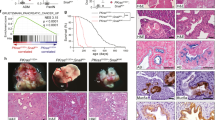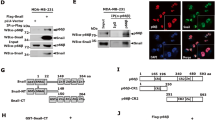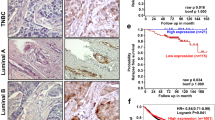Abstract
Snail is a zinc finger transcription factor that triggers the epithelial-mesenchymal transition (EMT) by directly repressing E-cadherin expression. Snail is required for mesoderm and neural crest formation during embryonic development and has recently been implicated in the EMT associated with tumour progression. In a series of human breast carcinomas, we have analysed the expression of Snail and that of molecules of the E-cadherin/catenin complexes. We have also correlated these data with the pathological features of the tumours. We show that Snail expression inversely correlates with the grade of differentiation of the tumours and that it is expressed in all the infiltrating ductal carcinomas (IDC) presenting lymph node metastases that were analysed. In addition, Snail is expressed in some dedifferentiated tumours with a negative nodal status. Considering that Snail is involved in the induction of the invasive and migratory phenotype in epithelial cells, these results indicate that it is also involved in the progression of breast ductal tumours, where it could additionally serve as a marker of the metastatic potential.
This is a preview of subscription content, access via your institution
Access options
Subscribe to this journal
Receive 50 print issues and online access
$259.00 per year
only $5.18 per issue
Buy this article
- Purchase on Springer Link
- Instant access to full article PDF
Prices may be subject to local taxes which are calculated during checkout



Similar content being viewed by others
References
Batlle E, Sancho E, Franci C, Dominguez D, Monfar F, Baulida J, Garcia de Herreros A . 2000 Nat. Cell Biol. 2: 84–89
Berx G, Clenton-Jansen AM, Strumane K, de Leeuw WJF, Nollet F, van Roy F, Cornelisse CJ . 1996 Oncogene 13: 1919–1925
Bukholm IK, Nesland JM, Borrensen-Dale AL . 2000 J. Pathol. 190: 15–19
Cano A, Perez-Moreno MA, Rodrigo I, Locascio A, Blanco MJ, del Barrio MG, Portillo F, Nieto MA . 2000 Nat. Cell Biol. 2: 76–83
Carver EA, Jiang R, Lan Y, Oram KF, Gridley T . 2001 Mol. Cell. Biol. 21: 8184–8188
Cheng CW, Wu PE, Yu JC, Huang CS, Yue CT, Wu CW, Shen CY . 2001 Oncogene 20: 3814–3823
Comijn J, Berx G, Vermassen P, Verschueren K, Van Grunsven L, Bruyneel E, Mareel M, Huylebroeck D, Van Roy F . 2001 Mol. Cell 7: 1–20
Del Barrio MG, Nieto MA . 2002 Development. 129: 1583–1594
Droufakou S, Deshmane V, Roylance R, Hamby A, Tomlinson I, Hart IR . 2001 Int. J. Cancer 92: 404–408
Gamallo C, Moreno-Bueno G, Sarrio D, Calero F, Hardisson D, Palacios J . 2001 Mod. Pathol. 14: 650–654
Gamallo C, Palacios J, Suarez A, Pizarro A, Navarro P, Quintanilla M, Cano A . 1993 Am. J. Pathol. 142: 987–983
Grau Y, Carteret C, Simpson P . 1984 Genetics 108: 347–336
Hemavathy K, Ashraf SI, Ip YT . 2000 Gene 257: 1–12
Kohn E, Liotta L . 1995 Cancer Res. 55: 1856–1862
LaBonne C, Bronner-Fraser M . 2000 Dev. Biol. 221: 195–205
Locascio A, Nieto MA . 2001 Curr. Opin. Genet. Dev. 11: 464–469
Manzanares M, Locascio A, Nieto MA . 2001 Trends Genet. 17: 178–181
Mareel M, Behrens J, Birchmeier W, De Bruyne GK, Vleminckx K, Hoogewus A, Fiers WC, Van Roy F . 1991 Int. J. Cancer 47: 922–928
Nieto MA, Patel K, Wilkinson DG . 1996 Meth. Cell Biol. 51: 219–235
Nieto MA, Sargent MG, Wilkinson DG, Cooke J . 1994 Science 264: 835–839
Palacios J, Benito N, Pizarro A, Suarez A, Espada J, Cano A, Gamallo C . 1995 Am. J. Pathol. 46: 605–612
Perl AK, Wilgenbus P, Dahl U, Semb H, Christofori G . 1998 Nature 392: 190–193
Pérez-Moreno MA, Locascio A, Rodrigo I, Dhondt G, Portillo F, Nieto MA, Cano A . 2001 J. Biol. Chem. 276: 27424–27431
Poser I, Dominguez D, Herreros AG, Varnai A, Buetnner R, Bosserhoff AK . 2001 J. Biol. Chem. 276: 2461–2466
Ros M, Sefton M, Nieto MA . 1997 Development 124: 1821–1829
Sefton M, Sánchez S, Nieto MA . 1998 Development 125: 3111–3121
Tan C, Costello P, Sanghera J, Dominguez G, Baulida J, de Herreros AG, Dedhar S . 2001 Oncogene 20: 133–140
Van Diest PJ . 1999 J. Pathol. 187: 383–384
Vos CBJ, Clenton-Jansen AM, Berx G, de Leeuw WJF, ter Haar NT, van Roy F, Cornelisse CJ, Peterse JL, van de Vijver MJ . 1997 Br. J. Cancer 76: 1131–1133
Yokoyama K, Kamata N, Hayashi E, Hoteiya T, Ueda N, Fujimoto R, Nagayama M . 2001 Oral. Oncol. 37: 65–71
Acknowledgements
This work was supported by the Spanish Ministries of Health (FIS-01/985) and Science and Technology (DGESIC PM98-0125) and the Comunidad Autónoma de Madrid (CAM 08.1/0044/2000) to MA Nieto and CAM 08.1/0024.1/1999 to A Cano.
Author information
Authors and Affiliations
Corresponding author
Rights and permissions
About this article
Cite this article
Blanco, M., Moreno-Bueno, G., Sarrio, D. et al. Correlation of Snail expression with histological grade and lymph node status in breast carcinomas. Oncogene 21, 3241–3246 (2002). https://doi.org/10.1038/sj.onc.1205416
Received:
Revised:
Accepted:
Published:
Issue Date:
DOI: https://doi.org/10.1038/sj.onc.1205416
Keywords
This article is cited by
-
Prostate cancer metastasis and health disparities: a systematic review
Prostate Cancer and Prostatic Diseases (2023)
-
Immune Checkpoint Blockade Therapy for Breast Cancer: Lessons from Epithelial–Mesenchymal Transition
Molecular Diagnosis & Therapy (2023)
-
MEDAG enhances breast cancer progression and reduces epirubicin sensitivity through the AKT/AMPK/mTOR pathway
Cell Death & Disease (2021)
-
DIF-1 inhibits growth and metastasis of triple-negative breast cancer through AMPK-mediated inhibition of the mTORC1-S6K signaling pathway
Oncogene (2021)
-
RNA binding protein RBMS3 is a common EMT effector that modulates triple-negative breast cancer progression via stabilizing PRRX1 mRNA
Oncogene (2021)



